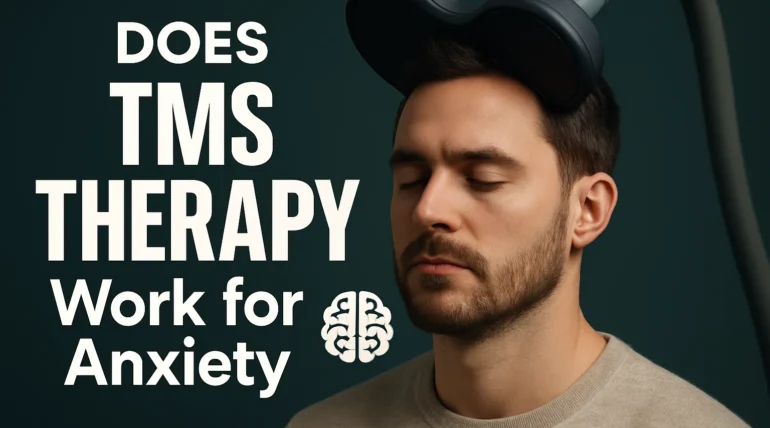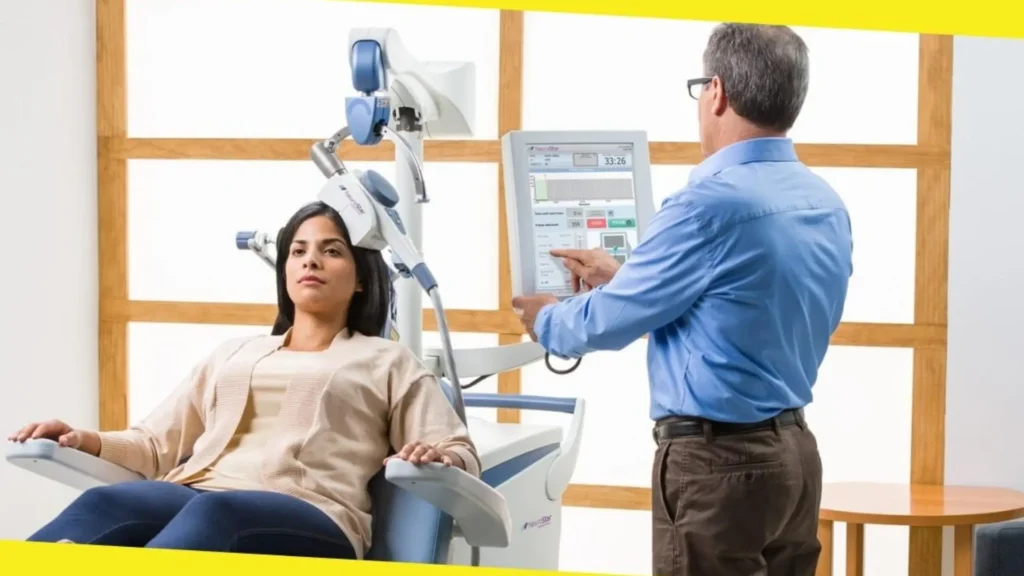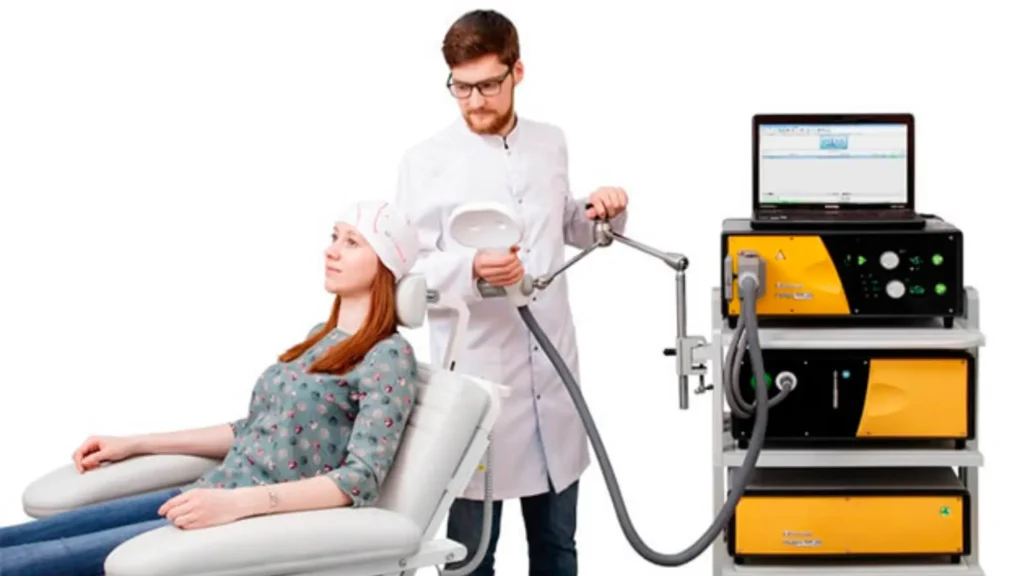
The feeling of anxiety may be a never-ending storm in your head. Once the conventional therapy, which may include drugs or even dialectical behavior therapy, does not appear to work, many individuals begin to seek other alternatives. TMS therapy – Transcranial Magnetic Stimulation is one of the treatments which have been attracting attention.
We are going to explore the inner workings of TMS therapy, what the science tells us about it, the actual outcomes of people who have tried the therapy, and the possibility that it is right as a potential choice in this blog.
What Is TMS Therapy?
TMS therapy (or Transcranial Magnetic Stimulation) is a non-invasive therapy with a light magnetic pulse, which stimulates parts of the brain associated with mood regulation and anxiety. It is approved in most countries as a way of treating depression and research has revealed promising results in the case of anxiety disorders as well.
A TMS session involves the use of a small magnetic coil that is positioned around the scalp and in which the nerve cells of certain parts of the brain are stimulated by pulses lacking pain. These magnetic pulses assist in reprocessing your brain, making you feel good, eliminating anxious thoughts, and balancing the mind.
Individuals tend to search for terms such as TMS treatment of anxiety, TMS depression treatment or transcranial magnetic stimulation of anxiety in search of drug-free and permanent therapy of mental health problems.
Why Is TMS Becoming So Popular?
TMS treatment is legalised in a significant number of nations, such as TMS-approved in France for depression, and utilisation has expanded all over the globe owing to its remarkable TMS success rate and the minimal side effects.
The reasons why more people are opting to use TMS therapy in cases of anxiety and depression are as follows:
- Non-drug treatment: No drugs are required, and this implies that there are no side effects such as drowsiness or weight gain.
- Non-invasive: No needles or surgical procedures are used; it is simply an outside-of-the-head magnetic stimulation.
- Effective for resistant cases: TMS is found to be effective in treating individuals who fail to respond to treatment or medication.
- Safe and FDA-approved: TMS has been approved by the FDA as a treatment for depression and is currently being studied as an anxiety therapy, as well as PTSD, and even autism.
There are numerous TMS therapy reviews posted by many patients who state that TMS rescued their lives from anxiety and that they are now relaxed.

TMS Therapy Works for Anxiety
How Does TMS Help with Anxiety?
One should be aware of what is happening in the brain to be able to determine whether the TMS therapy is effective in anxiety. The brains of people with anxiety tend to overreact in certain parts, such as the prefrontal cortex and amygdala which are in charge of fear and stress responses.
The transcranial magnetic stimulation (TMS) treatment of the brain involves using the magnetic pulse to target these areas. These pulses assist in resetting the hyperactive circuits and the brain is able to work at a slower pace.
The symptoms like constant worrying, racing thoughts, panic attacks, or physical tension usually reduce gradually in the patients after several weeks of treatment.
What Does a TMS Session Feel Like?
Naturally, many individuals get scared in their first session, and they are wondering what it is like. Here’s what usually happens:
- You are sitting well in a chair.
- A therapist who uses TMS places a small device close to your head
- The machine delivers rhythmical magnetic impulses to your brain.
- You can hear tapping noises and experience the slight tapping of your scalp.
- Each session is usually 20 to 40 minutes long and you can resume your normal activities immediately after the session, even driving.
According to the patients, it is painless and relaxing. In the long term, these sessions may produce perennial changes in brain activity that minimize symptoms of anxiety.
Scientific Proof Behind TMS and Anxiety
The clinical trials indicate great evidence of TMS therapy as applied to anxious depression and TMS therapy as applied to anxiety alone. Scientists have discovered that arousal of some parts of the brain results in a reduced state of anxiety, enhanced concentration and a positive mood.
For example:
- The Journal of Affective Disorders published a study that concluded that TMS treatment of generalized anxiety disorder patients demonstrated a significant improvement in symptoms.
- According to another report, individuals with depression and anxiety felt relieved under both conditions, indicating the close connection of each in the way the brain operates.
Scholars have attributed the effects of TMS when used to treat anxiety to the restoration of brain balance – the hyperactivity of the fight or flight system in the body that causes anxiety.
Real-Life Experiences and Success Stories
Most patients publish positive reviews of TMS therapy on the internet. You will frequently find remarks such as:
- After 6 weeks of treatment with TMS, I do not have panic attacks anymore.
- TMS saved my life from anxiety. I could not believe I would ever be this calm.
- I have been using medications for years. TMS therapy was the only thing that worked.
These narratives resonate with the increasing clinical evidence that treatment of anxiety with TMS might have real effects on individuals who have been struggling for many years.
Although the success rates of TMS therapy vary, it has been found that approximately 60-70% of patients can experience meaningful improvement. That is a big figure, particularly to those who did not respond to conventional treatment or medication.
Can TMS Make Anxiety Worse?
Some individuals experience a temporary rise in anxiety during individual sessions, which is only temporary. This is because the brain is adapting to the new stimulation. Nevertheless, all these effects tend to disappear in several days and the symptoms start to improve with the progress of treatment.
The majority of the patients claim that their anxiety levels start to decrease with time, which results in a permanent peaceful state and emotional balance.

TMS and Other Conditions
TMS therapy isn’t only for anxiety. It’s also showing promise for other mental health conditions, including:
- Depression – Widely recognized as TMS depression therapy.
- Autism – Early studies on TMS for autism suggest it may help improve mood and social functioning.
- Schizophrenia – Research on transcranial magnetic stimulation for schizophrenia is exploring its ability to reduce negative symptoms and improve brain connectivity.
TMS continues to expand as a safe and effective option for people seeking a non-invasive treatment for anxiety and other disorders.
TMS and Other Conditions
TMS does not treat anxiety only. It is also promising other mental illnesses such as:
- Depression – TMS has been widely known as a depression therapy.
- Autism – Preliminary experiments with TMS in autism show that it can be used to improve social functioning and mood.
- Schizophrenia – Some studies on the use of transcranial magnetic stimulation in treating schizophrenia are examining its potential to minimize the negative symptoms and enhance connections in the brain.
TMS is now growing as a safe and effective alternative for treating people with non-invasive modalities of anxiety and other disorders.
Benefits of TMS Therapy for Anxiety
The TMS therapy is effective in alleviating anxiety, and some of its main advantages include the following:
1. Non-Invasive and Drug-Free
You do not need to use drugs and experience their side effects. TMS is non-invasive and utilizes gentle magnetic pulses in vivo.
2. Lasting Results
A significant number of patients who have undergone the treatment report being relieved of anxiety problems in the long term.
3. Safe and Comfortable
There is no need to use any surgery, anesthesia, or hospitalization. Your session can be concluded immediately after your daily routine.
4. High Success Rate
The response to TMS in treating anxiety and depression is very high, and most patients have seen life-changing effects.
5. Can Be Combined with Therapy
TMS may be used in combination with talk therapy, with even greater outcomes.
Tips for Getting the Most Out of TMS Therapy
These are a few tips that you can follow to achieve the maximum results in case you are considering TMS treatment for anxiety.
- Be consistent: Be punctual to all your sessions. TMS is most effective as a routine therapy in several weeks.
- Stay patient: It might take a matter of weeks to see the results but it is worth it.
- Combine with lifestyle changes: Relaxation, mindfulness, and a healthy routine should be practiced in addition to your sessions.
- Communicate with your therapist: Let her know about any side effects or emotional changes – your TMS therapist can change the treatment as it works.
- Track your progress: To monitor your moods, sleep and stress levels, use a simple journal to keep track of your progress.
Conclusion
It is really effective for many people. Having a high rate of success, soft therapy, and long-term advantages, TMS has turned out to be one of the most promising treatments today in the treatment of anxiety and depression. It assists in relaxing the mind and brain training, as well as regaining balance without drugs or surgical interventions.
When your life has been dominated by anxiety, then it is time to think about transcranial magnetic stimulation therapy as a new way of achieving peace.
To learn further about TMS therapy, visit Minds Over Matter, a reliable source of mental health and wellness solutions.
FAQs
TMS Transcranial Magnetic Stimulation is a non-invasive procedure that involves the use of magnetic impulses to activate the parts of the brain that control moods and anxiety.
Yes. Most of the research and patient experiences indicate that TMS treatment of anxiety disorders can lead to a significant decrease in symptoms and an increase in mental health.
The improvements can begin in 2-4 weeks of the regular sessions; however, it may vary.
TMS therapy is successful in all cases of anxiety and depression, between 60-70 percent, depending on the individual.
Yes. It is tested bythe FDA, free of drugs, and is regarded as a safe and effective one in treating depression and anxiety.


